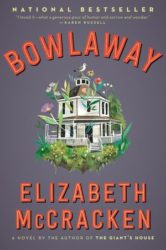The Arts Fuse Mentorship Program: Student Reviews from Somerville High School

Editor’s Note: The Arts Fuse Mentorship Program invites high school students from diverse backgrounds (in this go around from Somerville High School) to team-up with Arts Fuse critics. The goal is to educate young people about writing arts criticism. A reviewer works with a student; they select what will be reviewed — a book, a performance, a concert, a video game, a television show, etc. They then discuss writing strategies and go over successive drafts of the review. When the piece is deemed ready, it is posted on The Arts Fuse. Thanks to the Somerville Arts Council for its support of this innovative program this year. A trio of reviews below. — Bill Marx
A Book Review
By Jackson Anderson
(teamed with editor Bill Marx)
Bowlaway by Elizabeth McCraken. Harper Collins.

Life is like bowling. Specifically, candlepin bowling, according to Elizabeth McCracken. Her generational novel Bowlaway follows the life of a candlepin bowling alley from its founding in the late 19th century through to the mid-20th century, focusing on the characters who interact with the alley: the owners, the bowlers, and the workers. McCracken develops her characters to mirror the sport they play in this unique setting; she builds depth to these characters by exploring their backgrounds and their feelings only to toss them aside. Like pins, these characters are set up only to be knocked down.
McCracken does well with the prose of her narrator, who delivers astute observations and character development with compelling prose. Descriptions like “they were both doomed, which is to say they’d both courted that feeling of doom. They loved it, the shadow over the sun that meant your own fuckups were not personal: they were ordained and condemned by God” are common throughout the text.
These captivating passages set up a contrast which McCracken utilizes; although she spends multiple pages delving into a character’s feelings or backstory, the attachment McCracken instills in her readers has no bearing on the outcome of the character itself. The protagonist Bertha Truitt, for example, is dead after only 80 pages, despite all the care McCracken put into defining her traits and establishing her persona. This discrepancy between a character’s perceived importance and their destiny is effective in highlighting the randomness of life, which relates to the similar unpredictability in bowling well. Even the demise of Bertha strengthens this theme of chance, since she only happens to be in Boston during the Great Molasses Flood.
The novel also does well to tie in historical events throughout the lifetime of the alley while still maintaining an independent narrative. Through the First World War, the Great Depression, and the growth of technology, the alley experiences changes without letting history dominate its story.
Yet, the alley itself does not provide enough of a narrative; a place is not necessarily a story, the characters are. Although there are many subplots to latch onto, the characters are relatively separate in their narratives. They only face the fate the author has assigned them, one which often excludes the involvement of other characters. Occasionally characters do affect one another. Even though Bertha dies early on, her legacy of the bowling alley and her influence on characters like Joe Wear continue to mold the novel. In other instances, though, the dead are never revisited. With entire plotlines cut short by the death of a character—like Jeptha Arrison—the book feels like just a progression of stories without a common focus.

Jackson Anderson
This could be seen as a lapse in McCracken’s approach, but I interpret it as contributing to the arbitrary and capricious model of life she creates. In this sense, the plot—however frustrating for its insufficient cohesion—achieved McCracken’s intention of chance for that very reason. This choice was functionally questionable but artistically effective; nevertheless, there is no centralized, orderly drama which traditionally defines a novel’s plot, so the novel suffers.
Due to this disjointed nature of the stories, the conclusion of the novel is devoid of resolution; without a sense of order, there is no satisfaction. The gold in the safe—what is supposed to be the “big reveal”—is anticlimactic. Although gold is traditionally symbolic of success, McCracken does not present her characters as materialistic, and wealth is not even a prevalent theme. The safe itself is only ever mentioned a handful of times throughout the novel. The other revelation is Joe Wear’s ownership of the alley and return to Salford. The reader is then left with Joe, at 80 years old, leaving town to start a new life. This would be hopeful, except that Joe is no longer relevant. He disappears halfway through the book, only to reappear and have his life summed up in 20 pages. Even for a book that is meant to emphasize the randomness of life, it trivializes life beyond a point of enjoyment.
So, even though McCracken accomplished her purpose of illuminating the fickleness of human existence, the story through which she conveyed this vision does not make for a satisfying novel. When she kills off these beloved characters with little warning and the reader scrambles to find meaning in this destruction, they come up empty-handed. Such termination of characters and their stories is both the most significant and the most annoying aspect of the novel: significant because it serves as the main vehicle of her message, yet annoying because it inhibits the progression of a coherent narrative.
If McCracken herself was a bowler, she would be excellent; she knocks down her characters like pins and understands the randomness of it all. Unfortunately, her vision that life is arbitrary is inherently contrary to creating a coherent novel. Readers come to novels not to be reminded of the unpredictability of life, but to find meaning in it. Therefore, McCracken is accurate that life is like bowling. This is just not a gratifying truth on which to base a novel.
Jackson Anderson has graduated from Somerville High School and is a freshman at Williams College.
A Theater Review
By Adriana Martinez
(teamed with theater critic Erik Nikander)
Trigger Warning by Jacques Lamarre. Directed by David J. Miller. Staged by the Zeitgeist Stage Company at the Boston Center for the Arts, through May 4, 2019.
Trigger Warning by Jacques Lamarre tells the story of a family in the aftermath of a school shooting. It begins with parents Jackie (Liz Adams) and Murph (Steve Auger) receiving word about the shooting happening at their kids’ school. We soon learn that their son, Travis, is the shooter, and that he shot his own sister, Meghan (Lilly Brenneman), in the leg, an injury she survives. Travis shoots and kills himself after a standoff with the police, and from that point on the story follows the lives of Travis’s family members as they deal with what has happened. The family immediately faces criticism and blame from their community. No one seems to care that they, too, lost a child that day. The aftermath of this incident starts to chip away at the family’s already crumbling relationships.

Adriana Martinez.
Trigger Warning puts its focus more on characters than plot, but the dynamic between the main characters and their relationships felt unrealistic, especially the interactions between the parents and their daughter, Meghan. Both Jackie and Murph completely write off Meghan’s anger as teenage angst, not considering the trauma she might be suffering from after being shot by her own brother. When Meghan storms out of the house after an argument with her parents, Jackie jokes that she won’t get far since she is wounded and didn’t grab her phone charger on the way out; they laugh off the pain she clearly feels in a tasteless, unnecessary way. Another weak aspect of the dialogue is the excessive use of profanity. A certain amount of swearing can shock the audience or add to the characters’ personalities, but relying too heavily on cursing loses its impact and authenticity fast.
The dialogue between the characters, as they discuss their internal struggles, feels repetitive. The parents, who are in almost every scene, undergo no significant change or character arc. Because of this, the story drags on. We revisit the issues of blame, guilt, and anger, but these never lead to concrete character development. By the end of the show, each main character’s viewpoint on the situation doesn’t change. Jackie still blames herself and Murph for how Travis turned out. Meghan is the only one that ultimately takes matters into her own hands and makes decisions to help herself move on and deal with her trauma in a healthy way.
The show’s technical elements are a redeeming quality. The production’s use of the set and space is efficient and effective. On the left wall, there is a poster hung up that seemed to illustrate a battlefield from the Civil War. On the opposite wall there is a creepy family portrait with everyone in the family besides Travis wearing all white. News clips and social media videos are projected cleverly onto the walls. The black box theatre allowed for only one set location, the family’s home. Even when confined in this way, director David Miller’s staging allows the characters to use the set in a variety of ways. Towards the end of the show, both parents confide in others close to them about their guilt and anger towards the situation. As Murph has a conversation with their attorney, Jackie has a heart-to-heart with Reverend Tracy. Even though Murph and Jackie are in different locations within the context of the play, the choice to have the actors sitting on the same couch shows the similarity between the parents and their shared internalized guilt over the situation, without blatantly telling this to the audience.
Trigger Warning’s biggest downside is the playwright’s choice to focus more on the drama and less on the political conversation surrounding the school shooting. The few scenes that do address pertinent issues about mental health and gun laws feed the audience information in a way that feels overly instructive. When Meghan speaks to a large crowd at an anti-gun rally, she states that the country’s broken government doesn’t allow adequate resources for mental health, and that the NRA is a major factor behind corrupting politicians and controlling their policies. This is all conveyed within a short scene that felt rushed and not as fleshed out as it could have been.
Trigger Warning’s attempt to tackle the issues of gun violence and mental health don’t quite hit the mark. The overall message of the story is unclear, and the show leaves the audience uncomfortable for all the wrong reasons. Although the technical side of this production is impressive, it does not make up for the awkward dialogue and weak humor. A play written about such a sensitive, prevalent topic deserves a story with believable characters and a coherent message.
Adriana Martinez has graduated from Somerville High School
A Film Review
By Max Nadeau
(teamed with film critic Issac Feldberg)
Shazam!, directed by David Sandberg

A scene from Shazam!
Over a decade into the explosion of superhero movies, the biggest question facing yet another entry into the genre is that of differentiation. What can each new film do to stand out from all those that came before? 2019’s Shazam, starring Zachary Levi and Asher Angel as the two incarnations of its titular hero, follows a path less taken by its gloomier predecessors in DC comic book movies: a light, satirical take on the traditional superhero story.
Shazam tells the story of Billy Batson (Angel), a jaded teenager bouncing from foster home to foster home in search of his birth mother. An ancient wizard thrusts onto Billy the power to transform into the adult-sized, superpowered Shazam (Levi) – and the responsibility of reining in the seven deadly sins, manifested as ghoulish gargoyles who’ve escaped into the world. Billy is pulled from his day-to-day mischief and sent on his Campbellian Hero’s Journey.
Though it is ostensibly the story of a normal boy given superpowers and tasked with taking down evil, the movie is actually better when dealing with Billy’s interactions with his foster family, especially his new brother, Freddie (Jack Dylan Grazer). Both Billy and Freddie are depicted with nuance, heart, and refreshing realism. The two adolescents swing between unfettered joy in their explorations and exploitations of Billy’s new superpowers and principled disagreement as to Billy’s duties as a superhero, creating a well-written characterization of the duality between childhood and adulthood all teenagers must straddle. This dynamic also pairs well with the film’s back-and-forth between zany and serious tones, as its principal characters work so well with dialogue in either vein. The rest of their foster family exists primarily as background, each a single character trait personified, though unified by their mutual love for each other. One sibling is the nerdy gamer, another the studious high-schooler, another still the adorable innocent. Together, though, the ensemble produces a warm backdrop for Billy’s new life, a contrast with his initial isolation and self-sufficiency.
The movie provides a bland villain in Thaddeus Sivana (Mark Strong), a resentful man whose desire for revenge on his cruel brother and father makes him a gullible vessel for the seven sins. Sivana’s trite backstory and insecurities make for unexciting scenes of him gaining superpowers, killing innocents, and whining maliciously. And even with so much time devoted to Sivana’s machinations, his motives and larger plan still feel unclear, though the movie leans on the pure malice of the sins controlling him to explain the reasoning behind his garden-variety evildoing.

Max Nadeau
One scene in particular, in which Sivana finally gets long-awaited vengeance on his family, exemplifies the movie’s occasional issue with making the villain’s scenes too drawn-out, predictable, and flat. Though Sivana’s intimidation and violence blatantly assure the audience of his villainy, the humorless scene fails to create an interesting character out of him or to match the light tone of the rest of the film. That being said, Shazam sparks comedy from the dissonance between Billy’s goofy quips and Sivana’s ultra-serious scowling, making use of its stereotypical villain to act as a foil to the satirized hero. This juxtaposition appears, for example, when Sivana monologues towards Billy from a distance in preparation for their imminent fight, oblivious to the fact that Billy cannot hear him and is trying to say so.
Still, though, Shazam shines brightest when abandoning the familiar tropes of the crowded superhero genre and rooting itself firmly in the real world, both in comical and serious moments. Its best humor arises from Billy’s authentic discovery of the practical implications of his new powers. How does he go about discovering the range of his abilities? With a series of impromptu tests conducted in an abandoned warehouse, of course. How does he react to seeing criminal activity? Hesitation at first, until he realizes that he has the ability and obligation to intercede. How does he go to the bathroom while wearing his costume? Billy’s not sure, but he’s working on it. Similarly, the movie’s most poignant moments come entirely divorced from Billy’s powers, in the growth and decay of Billy’s relationships with his new and old family.
Shazam relays its plot effectively and directly, if perhaps not innovatively. We toggle between Sivana and Billy as they each gain and master their powers, reaching opposing philosophies and objectives that push them into inevitable conflict. Along the way, Billy undergoes another transformation, coming to appreciate and accept those who love him. These two plots dovetail nicely in the movie’s finale, as Billy’s newfound connections become at first his weakness and then his strength. This wise simplicity of plot allows the movie to focus on the teenage banter and hijinks, perhaps its greatest asset.
Shazam’s main message, that those with power have an obligation to use it justly and selflessly, underlies most superhero origin stories. Its other important theme, the value in looking out for and relying on those you love, is not particularly unique. However, Shazam’s authentic characters, directed plot, and warm humor combine these familiar ideas in a thoroughly entertaining, pleasantly character-driven movie.
Max Nadeau graduated from Somerville High School and now lives in Cambridge.
Tagged: Adriana Martinez, Bill-Marx, Erik Nikander, Jackson Anderson, Max Nadeau, Somerville Arts Council
